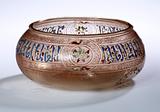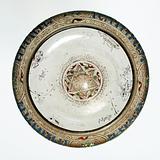Basin, colorless glass, decorated with enamel and gilding
Egypt or Syria; 14th century
H: 9.5; Diam: 21.7 cm
The basin has the same shape as contemporary brass bowls. Its decoration also includes elements that were found on the period’s inlaid metalwork, such as lotus flowers and the inscription in cursive Naskh calligraphy that repeats the word al-alim (“the wise”). On the inside of the basin, fish and sailboats were combined in an original way around a six-pointed star – perhaps a metaphor of the sun over the oceans.
The technique of decorating glass with polychrome enamel was developed under the Ayyubids, but reached a zenith in the Mamluk period, when glass of the type was also exported to Europe’s Christian realms and to the Far East. We know that the basin was in China in around 1900.
Inv. no. Isl 223
Published in:
Richard Ettinghausen: “Further comments on the Wade cup” in Ars Orientalis, 3, 1959, p. 198, pl. 1;
John Alexander Pope: “An early Ming porcelain in Muslim style” in Richard Ettinghausen (ed): Aus der Welt der islamischen Kunst : Festschrift für Ernst Kühnel zum 75. Geburtstag am 26.10.1957, Berlin 1959, pl. 7 B;
C .L. Davids Samling. Fjerde Del : Jubilæumsskrift 1945-70, København 1970, cat.no. 30, pp. 220-221;
André Leth: Davids Samling. Islamisk kunst = The David Collection. Islamic Art, København 1975, p. 74;
Art from the World of Islam. 8th-18th century, Louisiana, Humlebæk 1987, cat.no. 159;
Kjeld von Folsach: Islamic art. The David Collection, Copenhagen 1990, cat.no. 249;
Kjeld von Folsach, Torben Lundbæk and Peder Mortensen (eds.): Sultan, Shah and Great Mughal: the history and culture of the Islamic world, The National Museum, Copenhagen 1996, cat.no. 131;
Rachel Hasson: “An enamelled glass bowl with "Solomon's seal": the meaning of a pattern” in Rachel Ward (ed.): Gilded and enamelled glass from the Middle East, London 1998, figs 11.1 and 11.2;
Kjeld von Folsach: Art from the World of Islam in The David Collection, Copenhagen 2001, cat.no. 348;
Marco Spallanzani: Vetri islamici a Firenze nel primo Rinascimento, Firenze 2012, pl. 9, pp. 72-73;
Kjeld von Folsach: Flora islamica: plantemotiver i islamisk kunst, Davids Samling, København 2013, cat.no. 16;
Institute of Ismaili Studies: Encounters in Muslim History, Student reader 1, London 2017, p. 161;


